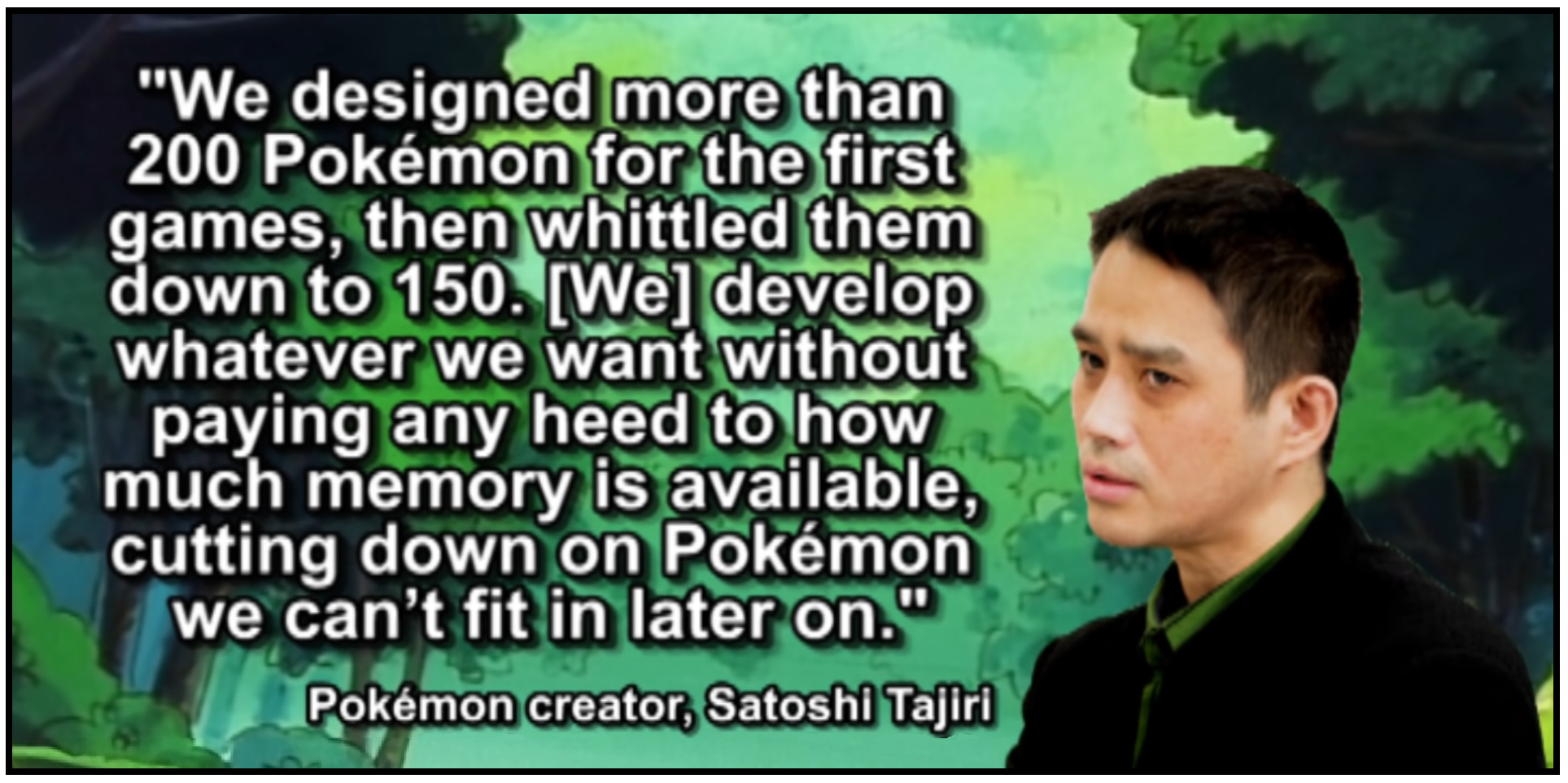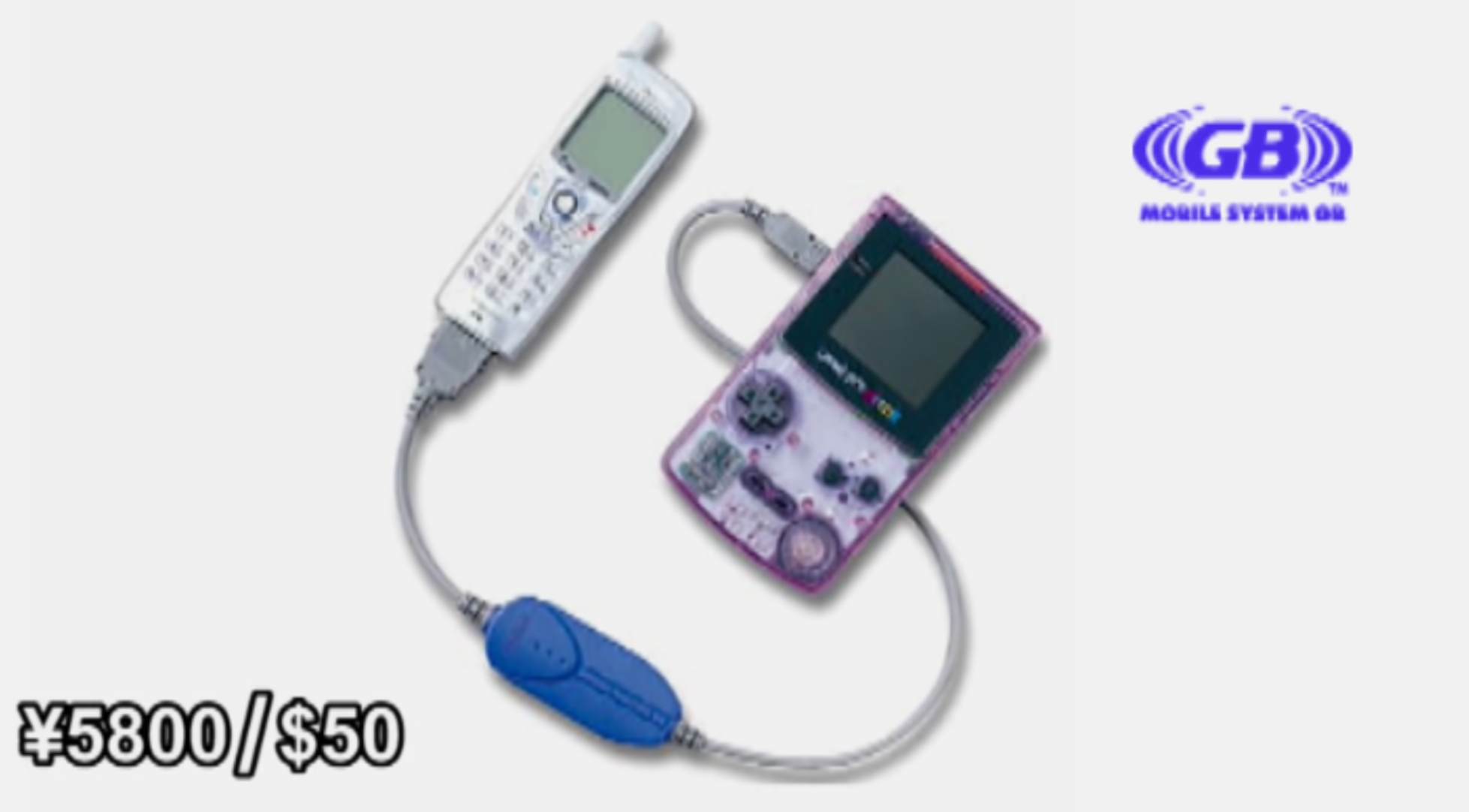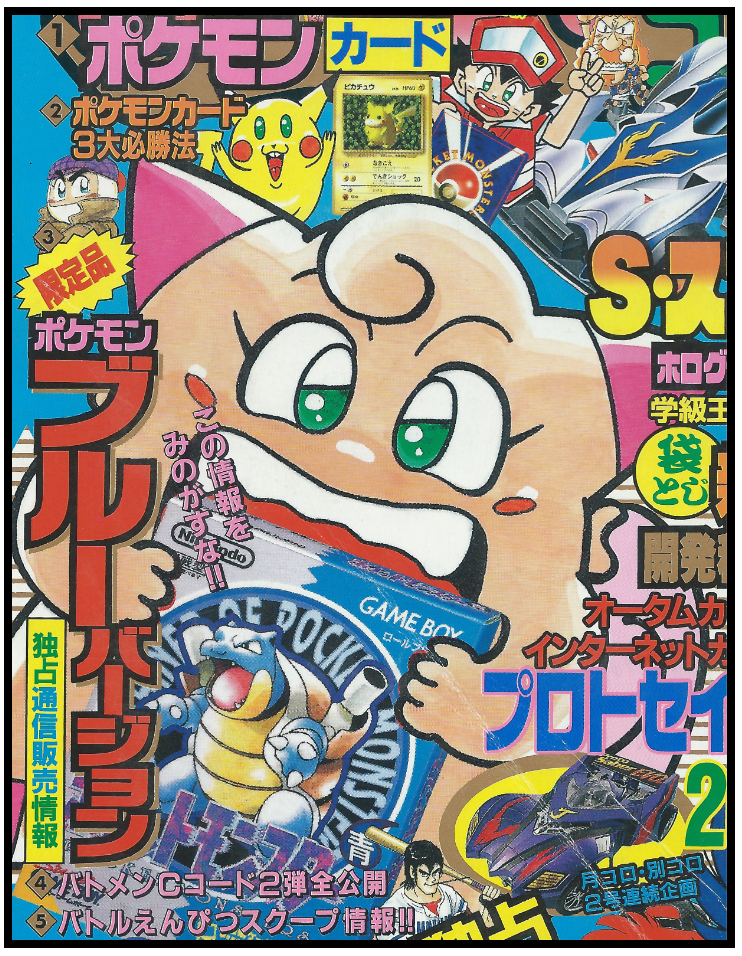
Translation: Forgotten Story of Pokemon Blue’s Release
Blue beta sprites & the full story behind Blue’s unique release
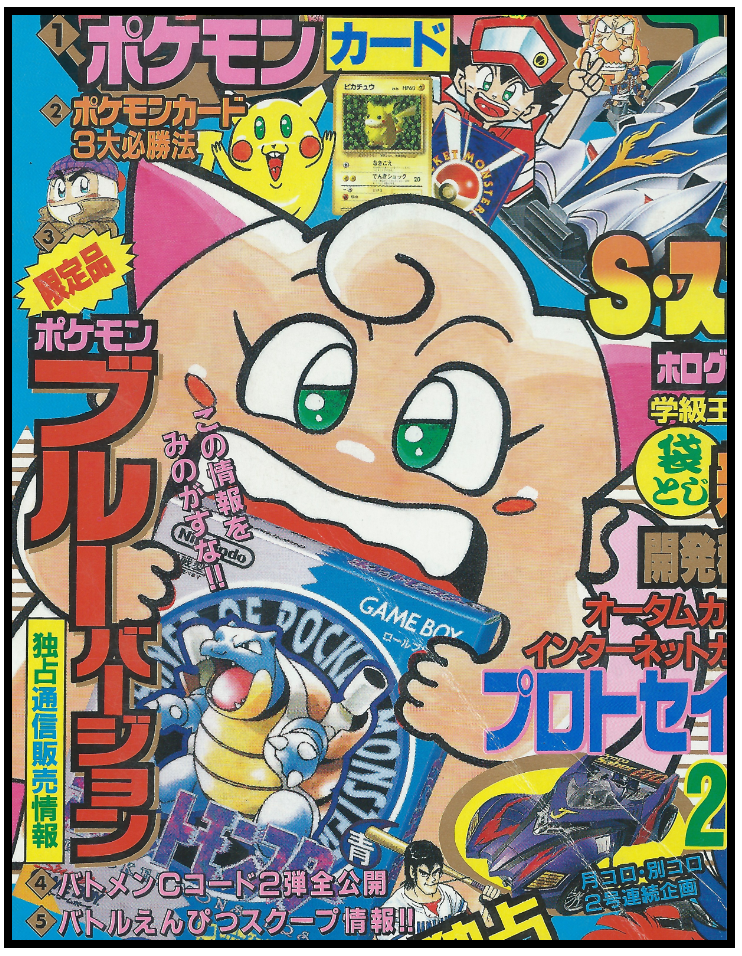
Written by Dr Lava, February 1 2020
Pokemon Blue’s launch in Japan was pretty unique, and as far as I can tell, the full story has never been translated into English. The original Pokemon games, Red & Green, released on February 27, 1996. They were later followed by Pokemon Blue, an updated version of Red & Green that featured new sprites for all 151 Pokemon, graphical updates, bug fixes, and a few more small changes. According to Wikipedia, Bulbapedia, and even Nintendo’s official website, Pokemon Blue launched eight months later on October 15, 1996. But actually, that’s not entirely true — the game was actually released about six weeks later, in early December 1996.
Using 90’s magazine scans and Japanese translations, this article will discuss how and when Blue really launched, how some Pokemon fans were able to skip out on paying, and we’ll also have a look at some unused Blue beta sprites. So let’s dig in, and take a look at how Pokemon Blue was really released.

The Story You Know
Pokemon Red & Green were released just like any other video game — they landed on store shelves in Japan on February 27, 1996. But Pokemon Blue was different. If you’ve heard the story at all, the version you probably heard is what’s on Bulbapedia: “Pokémon Blue Version is the third core series Pokémon game for Game Boy, released in Japan on October 15, 1996 exclusively to subscribers of CoroCoro Comic and on October 10, 1999 to general retail.” Bulbapedia cites the official websites of both Nintendo and the Pokemon Company as the source of that information. But the information provided by Nintendo and Pokemon doesn’t tell the full story, and it’s not entirely correct either.
But before we get to what really happened, let’s briefly touch on the importance of Corocoro Comic in early Pokemon history. Meant for elementary-aged children, Corocoro is a monthly Japanese magazine that began in 1977 and continues to this day. Every issue features lots of manga comic strips, as well as articles on hobbies, anime, and video games. As Pokemon Company CEO Tsunekazu Ishihara explained, “In 1996, people weren’t writing their own internet blogs… I strongly felt that the power of the media, centered around CoroCoro Comic, served to accelerate the growth in Pokémon’s popularity.”
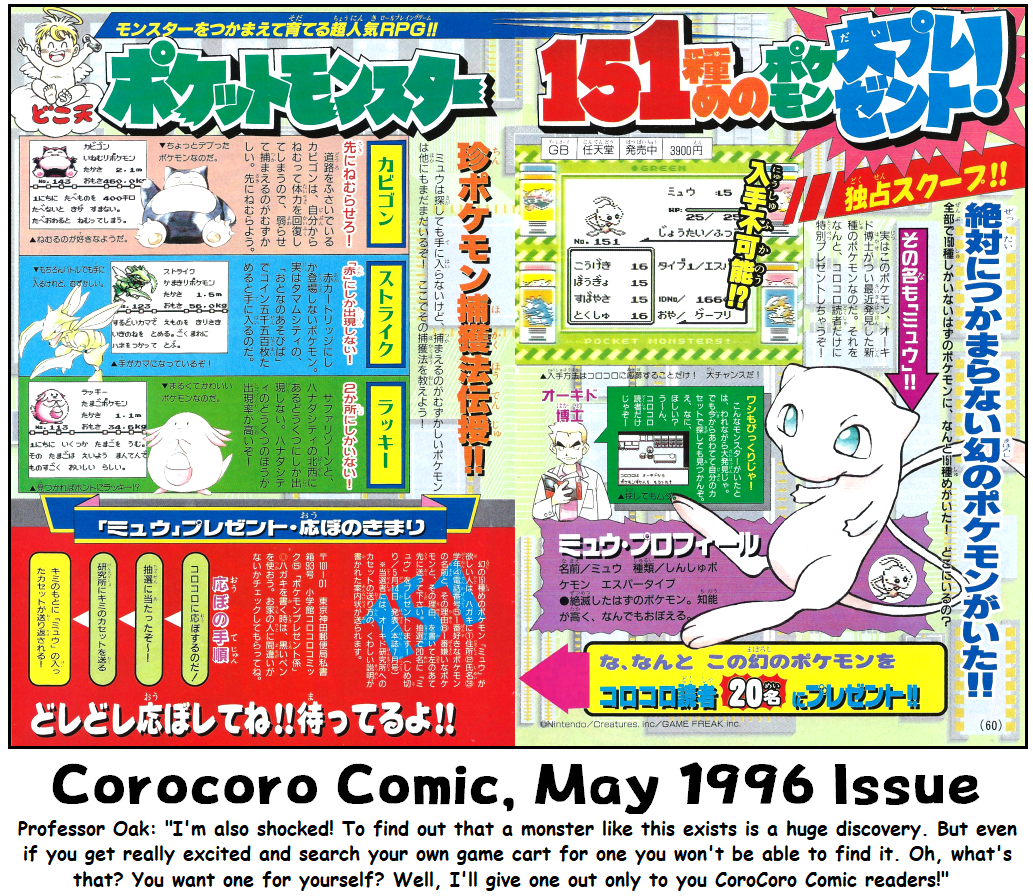
In the 90’s Corocoro was Pokemon’s primary marketing arm. In fact, the first official distribution of Mew was a Corocoro promotion. First announced in the May 1996 issue, the “Legendary Pokémon Offer” resulted in 78,000 fans sending in applications for a chance to win the elusive #151. Just twenty kids were selected, and each of them mailed in their copies of Red or Green to have Mew uploaded to their game, then mailed back to them. Now that was a rare Pokemon. And it gives you some idea how tight Pokemon and Corocoro were back in the 90’s.
Before continuing, I wanna give a shout-out to Dogasu’s Backpack. An American based in Japan, DB’s been writing about the Japanese side of the Pokemon series for over 20 years on his own website. He provided me with all the translation work and magazine scans used in this article, so I owe him a big thanks, and I definitely recommend checking him out.
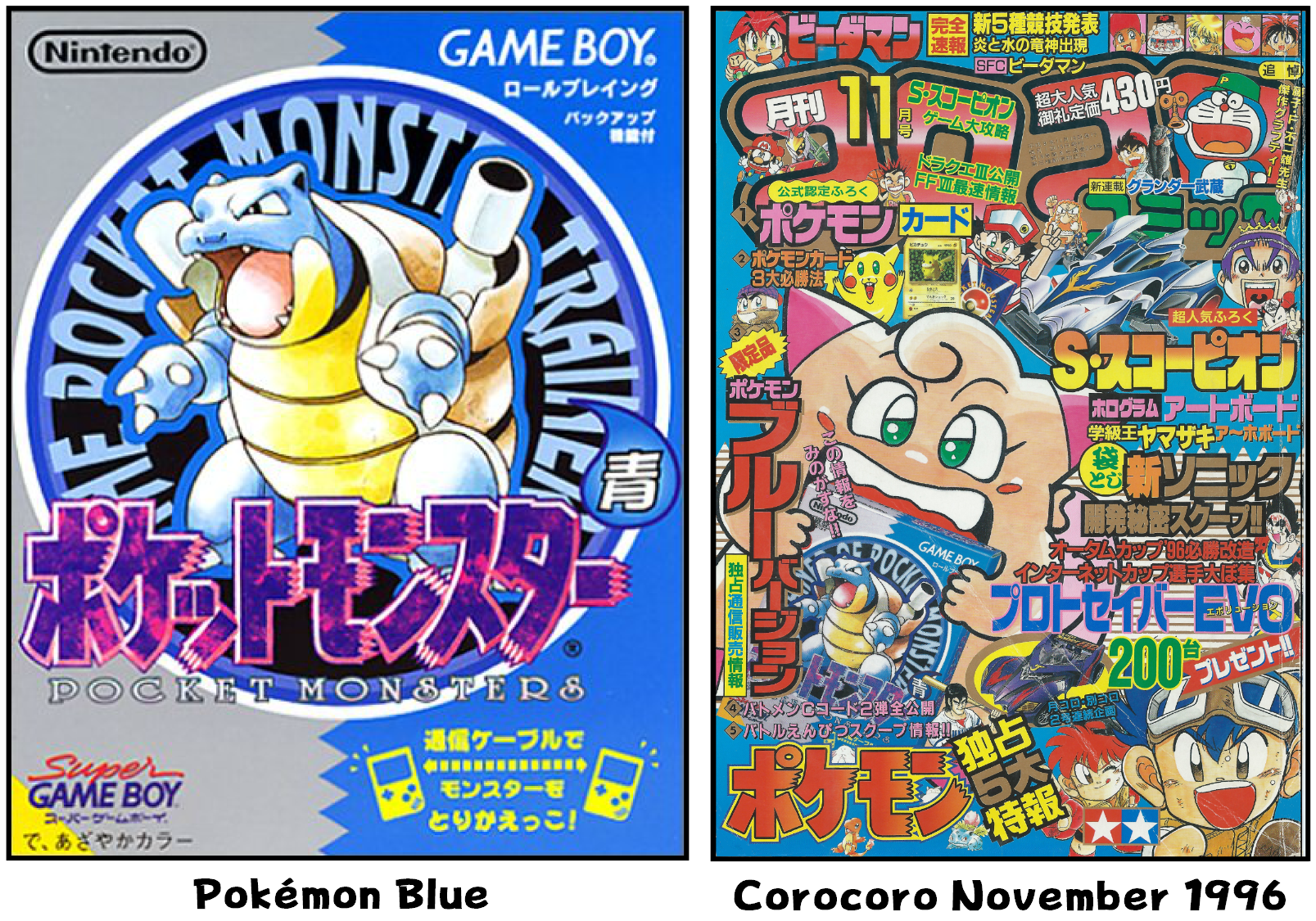
The Full Story
Six months after the Mew promotion, the November edition of Corocoro Comic arrived in subscribers’ mailboxes — right around October 15, 1996. This new issue announced a new Pokemon game called Blue was being made available exclusively to Corocoro readers. It also included an application form readers needed to mail in to purchase a copy of Blue, as well as a set of instructions. This is where things begin to diverge from the official story, and there are some devils in the details.
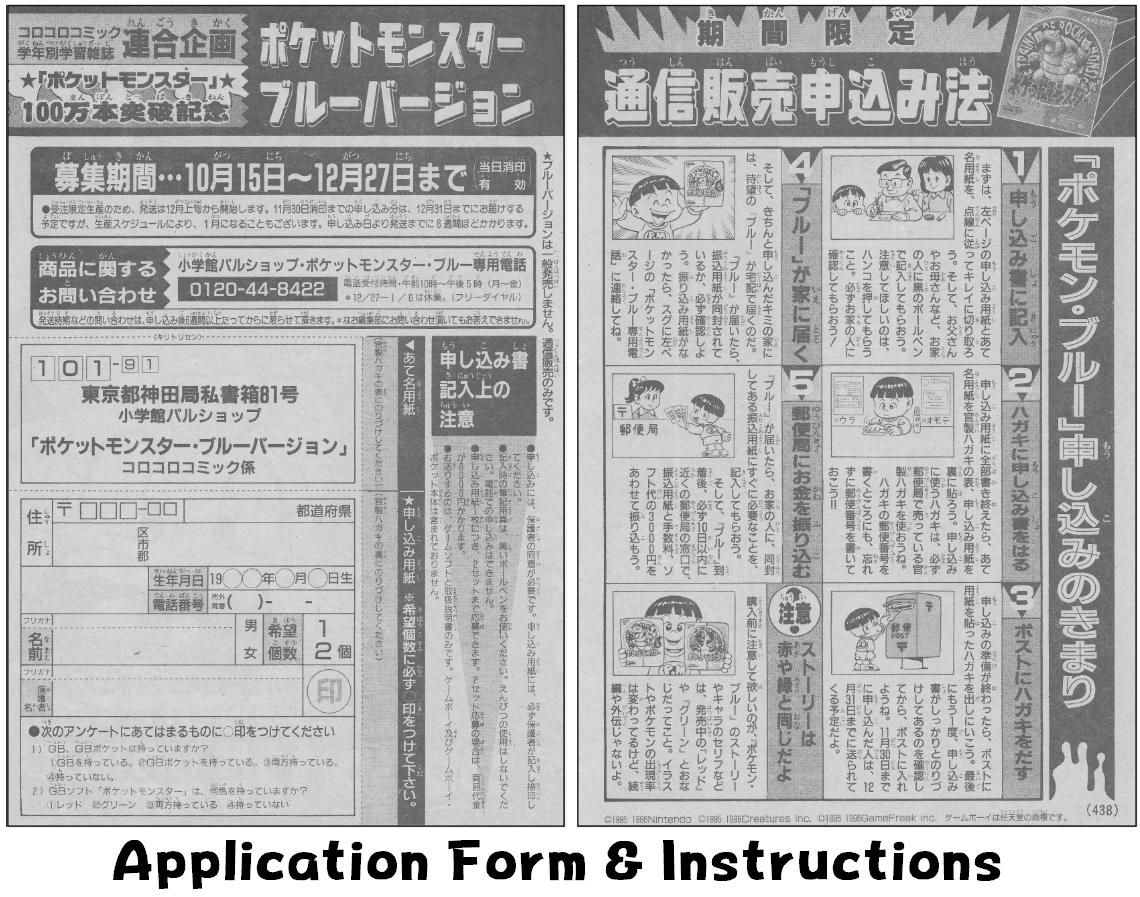
I won’t include a translation of the application itself, since it’s exactly what you’d expect — it asks for the reader’s name, address, etc. But the instructions provide some information worth our attention, and they’re accompanied with a cute little comic as well. So let’s look at a translation of the instructions, then pick apart the key details.
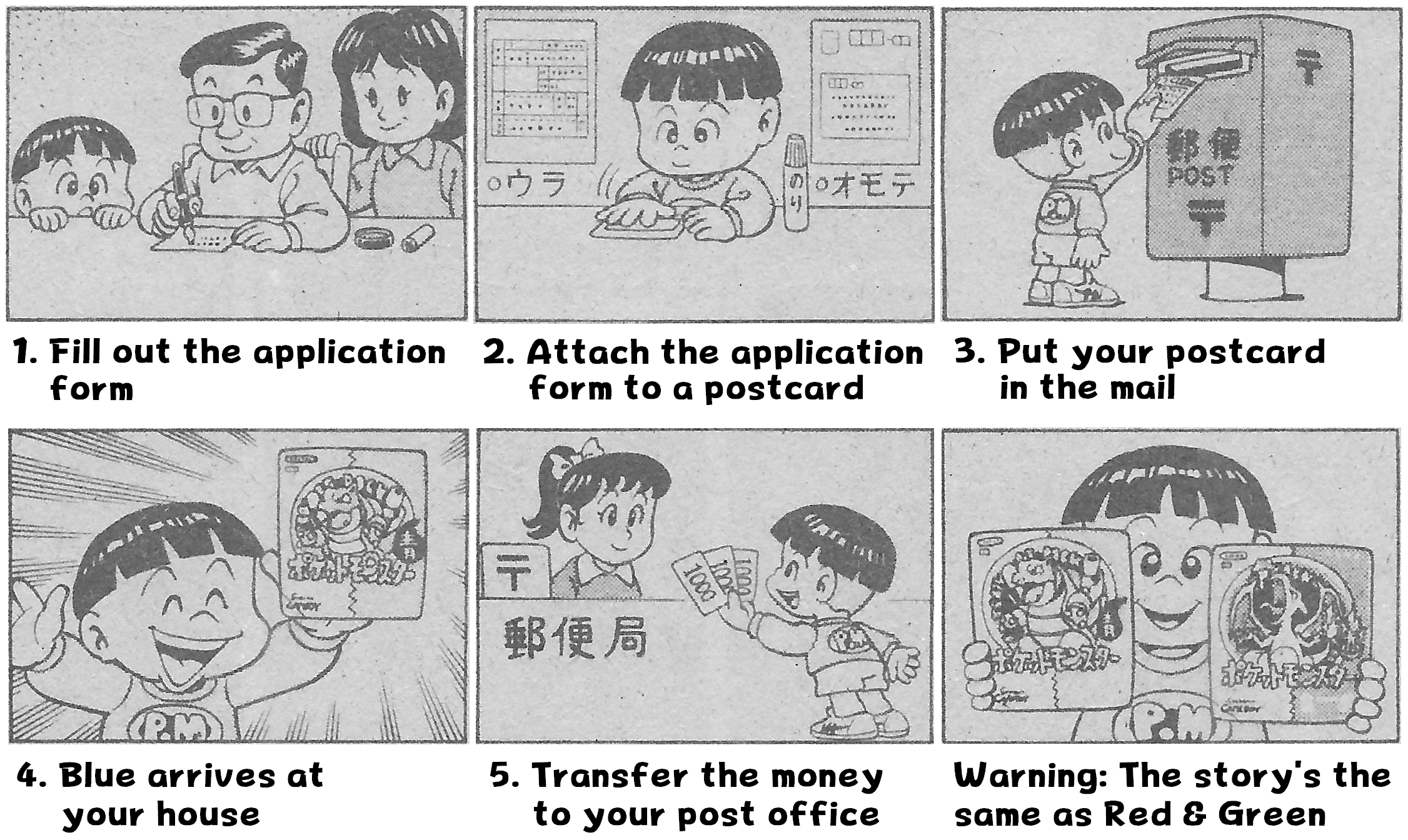
★ Limited Time Offer ★ To commemorate Pokemon surpassing 1 million copies ★ Blue version is not being made available to the general public. It is available through mail order only ★
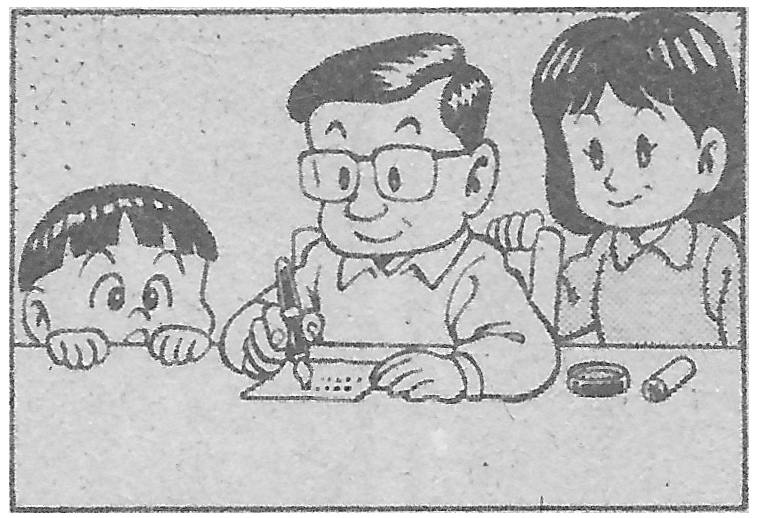
1. Fill out the application form: First, carefully cut out the application form and address forms along the dotted lines on the left-hand page. Then, have your mom, dad, or other adult in your household fill it out using a black ballpoint pen. Don’t forget to stamp the application form with a personal signature stamp. Have someone in your house double check.
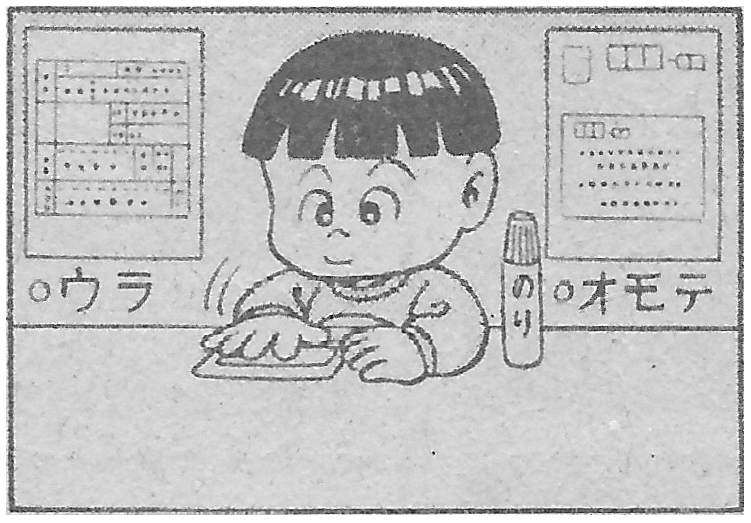
2. Attach the application form to a postcard: When you finish the application form, attach the address label to the front and the application form to the back of a government Hansei postcard. Make sure the postcard used for the application form is a government Hansei postcard sold at the post office. Also, make sure not to forget to write your postal code!!
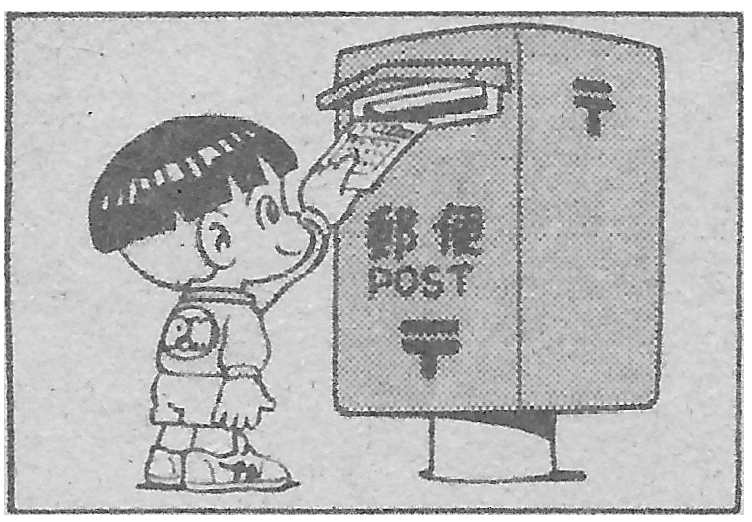
3. Put your postcard in the mail: Once everything’s ready, it’s time to put the postcard with your application form into the mailbox. Make sure the application form is attached firmly to the postcard with glue one last time. Those who apply by November 30th are scheduled to have their game sent out by December 31st.
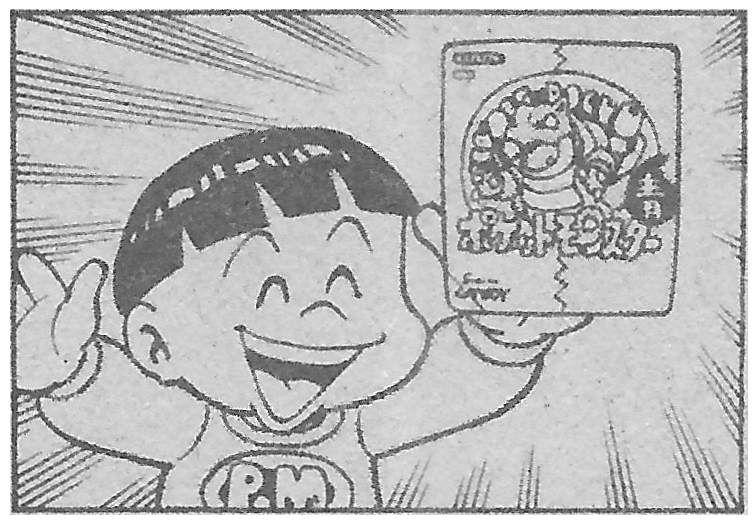
4. Blue arrives at your house: Next, if everything’s filled out properly, the long-awaited Blue will arrive at your house via mail. Check to make sure a bank transfer form is included in the package. If the bank transfer form isn’t there, please contact the “Pokemon Blue Hotline” listed on the next page as soon as possible.

5. Transfer the money to your post office: After Blue arrives, have someone in your house fill out the necessary information on the bank transfer form packaged with the game. Then, go to the post office and transfer 3,000 yen for the cost of the game, as well as the handling fee within ten days of receiving Blue.
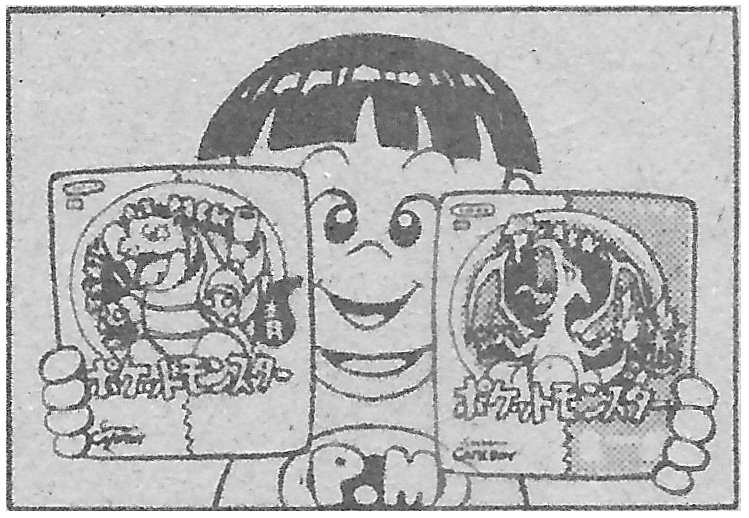
Warning. The story’s the same as Red & Green: Before you buy Pokemon Blue, we want to make sure you know that the story, character dialogue, etc are all the same as the Red & Green games already on sale. While the game art and Pokémon appearance rates are different, Blue is not a sequel or a side story or anything like that.
Application Period: October 15th – December 27th (postmarked) Game cartridges will be produced based on the number of orders received, so games will start being sent out in the beginning of December. Applications postmarked by November 30th are currently scheduled to arrive by December 31st but they may not get to your house until January based on the production schedule. It’ll take approximately six weeks from the time applications are received to the time the games are sent out.
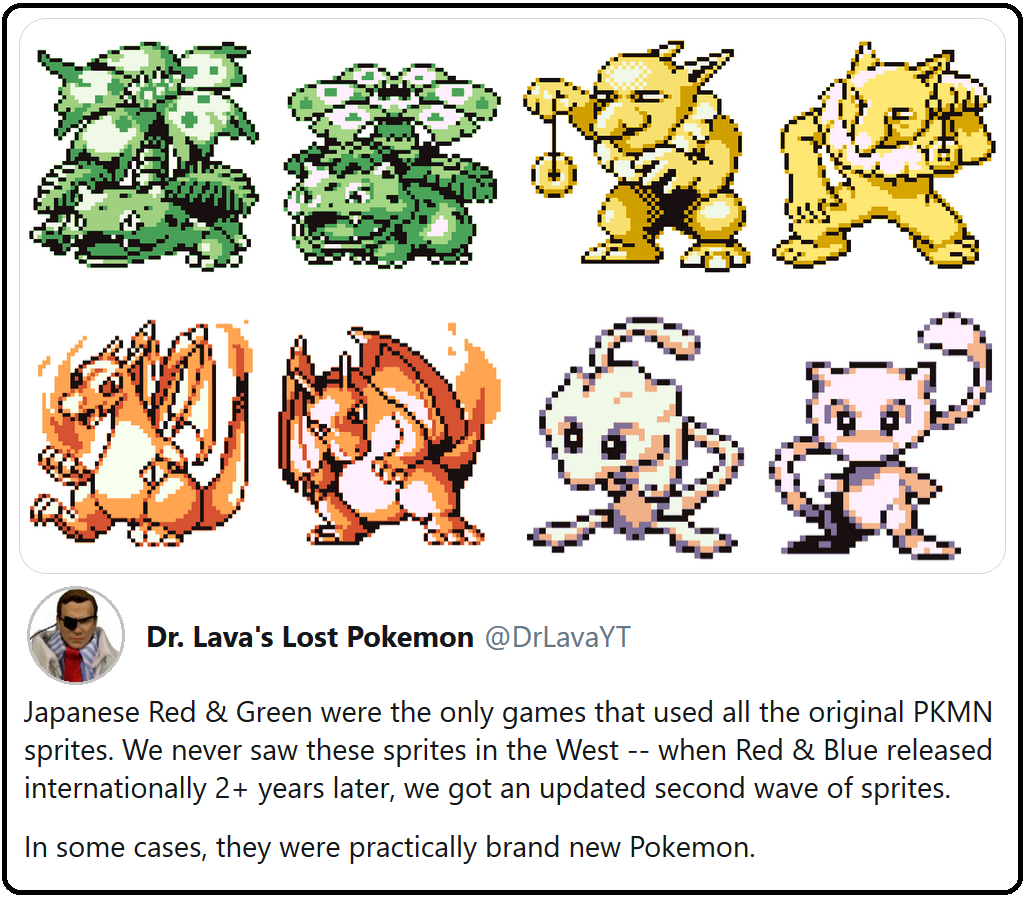
Analyzing the Instructions
There’s a few things to point out here, but the most important detail is obviously the release date. Blue is officially recorded as launching on October 15, 1996 — but actually, that was the release date of this issue of Corocoro. The comic itself is quite clear — it took about six weeks from the date Corocoro received an application, until that reader’s copy of Blue was shipped out by Corocoro. It also clearly states that the earliest a fan could hope to get their hands on Blue was actually in early December… not October 15.
Considering the details of the promotion, it sounds like Game Freak and Corocoro didn’t have a lot of confidence in customer demand for Blue, or at the very least, didn’t know what to expect. So they decided to utilize a made-to-order sales model — that is, they took orders, then produced a quantity of games to match the number of orders. This is in contrast to the standard made-to-stock model, where games are produced in a factory run, in hopes that every copy produced will be sold. If the game is successful, the company orders at least one more additional factory run. So it seems Blue is unique in that respect — it was the only made-to-order Pokemon game ever produced.
Another interesting detail is that customers received their games first, then were expected to schlep down to the post office and wire 3,000 yen ($28.50) plus a shipping fee to Corocoro later. This issue says nothing about any sort of punishment or consequences meted out to freeloaders. In other words, whether or not kids actually paid for Blue was based entirely on the honor system. Undoubtedly, lots of customers never paid — because they didn’t have to, they forgot, or maybe issuing payment was just too complicated for a little kid.
Elsewhere it says “You can apply for up to two copies of the game per application form. If you sign up for two copies, the cost comes to 6,000 yen.” No mention is made about how many applications can be sent in per household or by each customer, so I imagine some Pokemon fans took advantage — intentionally or not — and wound up with at least one free copy of Blue… possibly lots of copies. After all, aside from this Corocoro promotion, Blue wasn’t made available to the public until three years later, in October 1999. Pokemon was a massive phenomenon in Japan at this point, so undoubtedly, some fans snapped up extra copies of this new limited edition Pokemon game.
Before looking at Blue’s beta sprites, there’s one more small detail worth mentioning. Bulbapedia, Nintendo, and other sources always say Pokemon Blue was sold “exclusively to subscribers of Corocoro Comic.” But in reality, I’m sure lots of Pokemon fans without Corocoro subscriptions bought this particular issue at a magazine stand, and potentially could’ve bought several issues, then sent in multiple applications for two games each.

Blue Beta Sprites
Okay, now that we’ve covered when and how Blue launched, as well as the gaping loophole that allowed customers to skip out on paying, let’s look at this issue’s page 20. Blue version sprites for 19 Pokemon are featured, with most of them accompanied by their original Red & Green sprites. But actually, 6 of these Blue sprites did not end up getting used in Blue… or in any game ever, for that matter. In other words, these are unused Blue beta sprites.
Pictured below, I’ve organized these 5 beta sprites with their Red & Green and Blue release version sprites for convenient comparison. All the sprites in Corocoro are reversed, so I’ve flipped them horizontally, since this is how they would have appeared in-game.
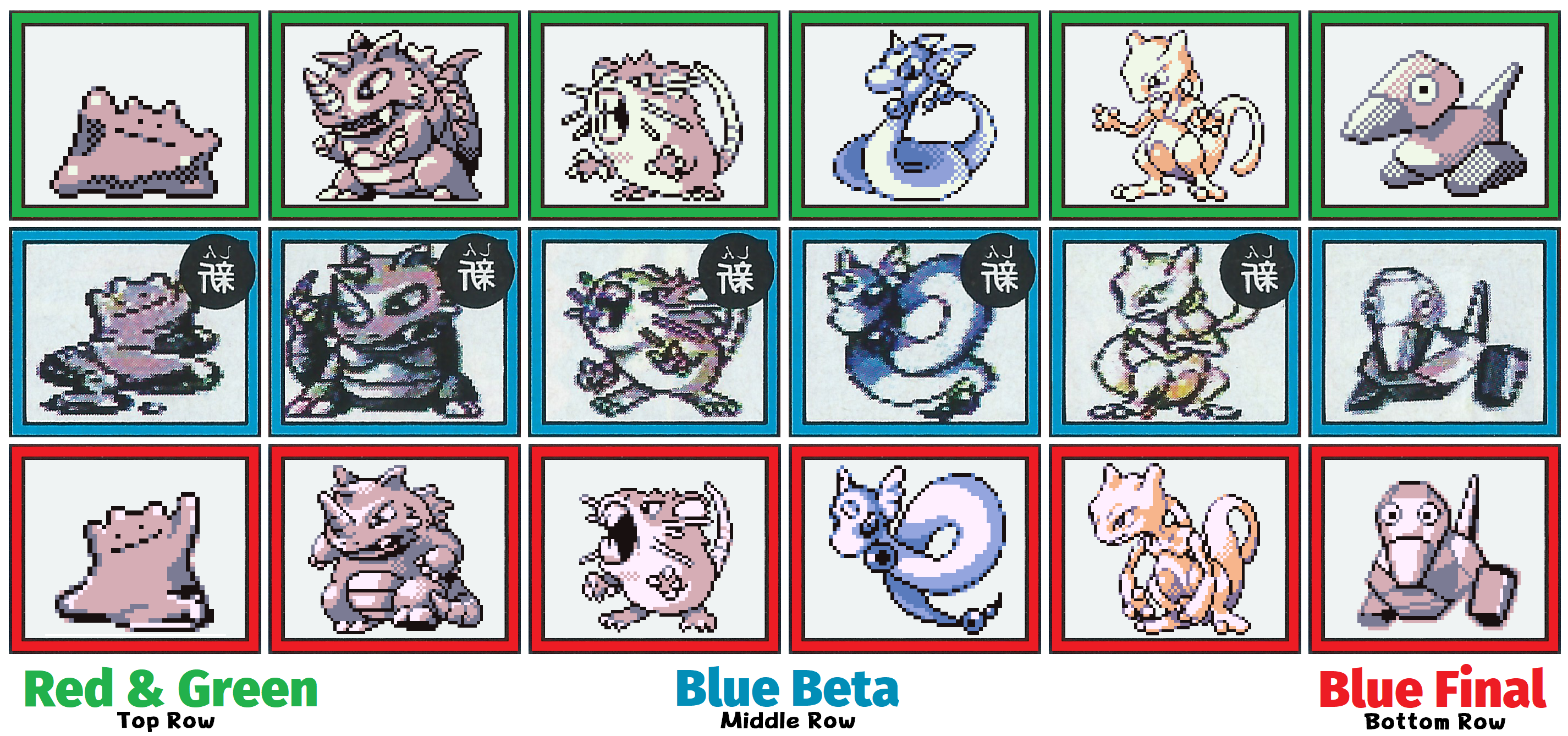
This scan is extremely high-resolution (7024×5113). But unfortunately, Corocoro Comic itself didn’t publish these sprites in full-resolution… they were slightly blurred. Rather than use a computer, Corocoro probably took a photo or just had a copy of a pre-release sprite sheet. Corocoro gives us a pretty good look, but unfortunately the images they published aren’t pixel-perfect. Since these Blue beta sprites were never published anywhere else, this is probably the best view we’ll ever get.
It’s worth noting that some pixels in these beta sprites appear to have been reused in Blue’s release version sprites. For example, the top third of Ditto’s beta sprite is identical to his final sprite. On the other hand, Mewtwo’s sprite looks like it was scrapped then rebuilt almost from scratch — only a few pixels on Mewtwo’s head were used in Blue’s final build.
Closing Comments
And there you have it, the full story of Pokemon Blue’s release and Corocoro Comic’s November 1996 edition. Thanks again to Dogasu’s Backpack — the completion of this article would have been impossible without his scans and translations. And also a big thanks to my Patreon supporters, whose contributions make documenting Pokemon History on this website sustainable. If you’d like to support my work for $5 a month, it’d really help out a lot when it comes to buying old Japanese magazines, commissioning translators, and other recurring expenses. Patreon supporters also get access to some unpublished translations and other cool stuff.
If you’d like to read about more Pokemon History, all my articles can be found on this site’s homepage, and I’ll include links to some of my favorite articles below. If you’d like to contact me for any reason at all, the best way to reach me is on Twitter, where I’m @DrLavaYT. Cheers guys, thanks for reading.
Read About Pokemon History:
• Gen 1: Controversy Explained: Red & Green Beta Sprite Leak
• Gen 4: Leaked Beta Sprites Reveal Scrapped Gender Differences
• Gen 5: Ken Sugimori Reveals Origins of Gen 5 Pokemon Designs
Videos About Pokemon History:
• Gen 5: Lost Pokemon & Beta Pokemon
• Gen 5: Scrapped Special Event: The Lock Capsule
• Gen 4: Internal Data & Cut Content
